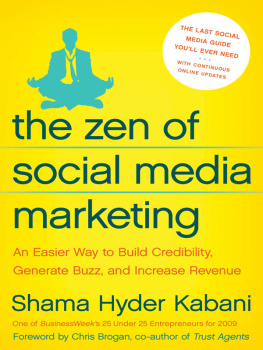Whenbuilding a social media presence for your business, selecting the appropriateplatforms can be tricky. Even for those who are used to working with technologydaily, the sheer number of options for social media can be daunting andjuggling them all can often be exhausting. Thats where this book is here tohelp. Social Media aims to help readers sift through the most prominentsocial media outlets in order to build a platform from which their newlybudding business can shine. Youll read about how to find your target audience,which website is best for certain businesses, what platforms will contribute tomarketing and sales simultaneously, and how to set up accounts on each of themajor social media platforms. So sit back and relax, because spreading the wordabout your business and gaining clients just got a whole lot easier.
Chapter 1: Facebook
Finding Your Audience
Facebookis undoubtedly one of the most popular and well-known social media platformsout there today. Many of the least tech savvy members of modern society aretaking part in the online platform. Some use it to connect with old friendsfrom high school or college; others use it to secretly plan birthday parties.For the purposes of this book, however, this chapter will explore how to shapeFacebook into a business tool by reaching out to a target audience and keepingthem involved in the every day events of the readers company.
Ifyou have never broached the subject of social media marketing before, this mayall seem a little disconcerting to you. So first, determine what your businessis and if Facebook is the right way to conduct the marketing for that business.If the company founder is opening a grocery store, this may not be the bestsocial media platform to use, although it can have some uses. This is becauseFacebook is used in large part to share and comment on information, as well asdiscuss new ideas. So for a grocery store, it may be best to create a websitewhere you can share recipes, deals, and allow access to coupons via barcodescanning (no worries, well get to this later!). However, if you are planningon becoming a freelance photographer, Facebook is a phenomenal way to get yourfoot in the door.
Nowthat you have determined that Facebook is indeed a positive way to spread theword about your company, figure out your target audience. Let us look to theprevious example of a photography business. Take into consideration what kindof photography you do; is it headshots, landscapes, or weddings? If you aregeared towards headshots, market to both the business and arts community, becauseof the potential white collar professional clients who need headshots for theirbusiness cards, and the actors who need headshots in order to submit forauditions. If you conduct landscape photography, invite everyone you know tolike your business page in order to gain popularity, as well as Facebookgroups that belong to publications (such as National Geographic and Time) sothat they can see the quality of your work in addition to how popular you are. Largerpublications are especially apt to take note if your content is frequentlyliked and shared (more on this below). And of course, if you are takingengagement and wedding photographs, market like crazy to those in their latetwenties, but be sure to include their parents. While this may seem confusing,remember that there are more ways to target specific age groups than to excludeundesired ages groups. If you take wedding photos and prefer to market to thosein their late twenties or early thirties, try posting photographs of people inyour target age group, or writing about an experience at a wedding thatfeatured a couple in their late twenties.
However,what if you are founding a company instead of working as a freelancing artist?Facebook can also be used to your advantage here, albeit in a slightlydifferent way. Lets take another example that is drastically different fromthe first. If a Facebook user were to begin an accounting firm, they couldcertainly create a business page within their personal Facebook account topromote the company. For the target audience, you would select those who are 18and older since that is when adults are responsible for doing their taxes.Please note that the minimum age for Facebook is thirteen, so if you inviteeveryone in your area via Facebook to like the page for your new liquor store,youll be catering to minors. Thus, it is not just strategically important, butalso legally advisable to select an age minimum when targeting an audience. Anotherexample of appropriate age marketing would be if the business in question werean old folks home. In this case, you would want to market your services forolder people and their children who are making the living arrangements. Whenconducting marketing for our theoretical accounting firm, frequent posts thatdetail the different services the office offers would be beneficial, perhapsspacing them out seasonally, such as notary services in the summer for weddingsand tax specials from January 1st through April 15th.There are numerous ways to boost your business social media presence; thelimits are bound only on your imagination.
Thereare a few Facebook terms users need to be familiar with that are listed below.
Status :This is how you post information on Facebook. At the top of every usersFacebook page, below their profile pictures, is a space to type out whatever ison your mind. This would be the place to post information, insert links tointeresting articles, and speak directly to your audience.
Like :This means exactly what it infers. When someone reads your status on theirFacebook and likes it, they can press a button just below your status that sayslike. The more popular your status is, the more likes youll generate.Facebook also recently added a new feature that allows users to specify theiremotion, so that instead of just liking a status, they can say the statusmakes them angry, shocked, sad, or that it made them laugh. The like buttonalso applies to photographs you post.


















